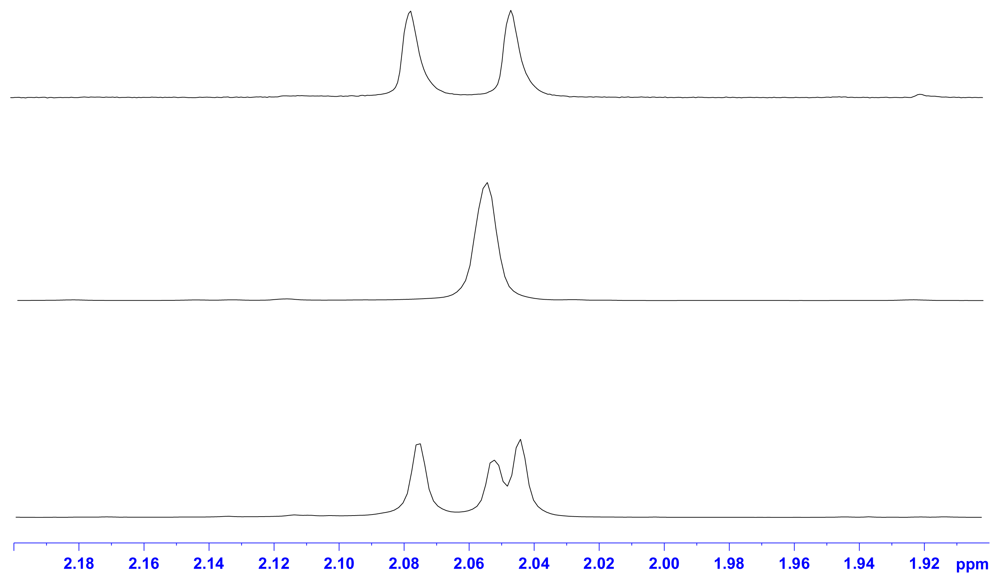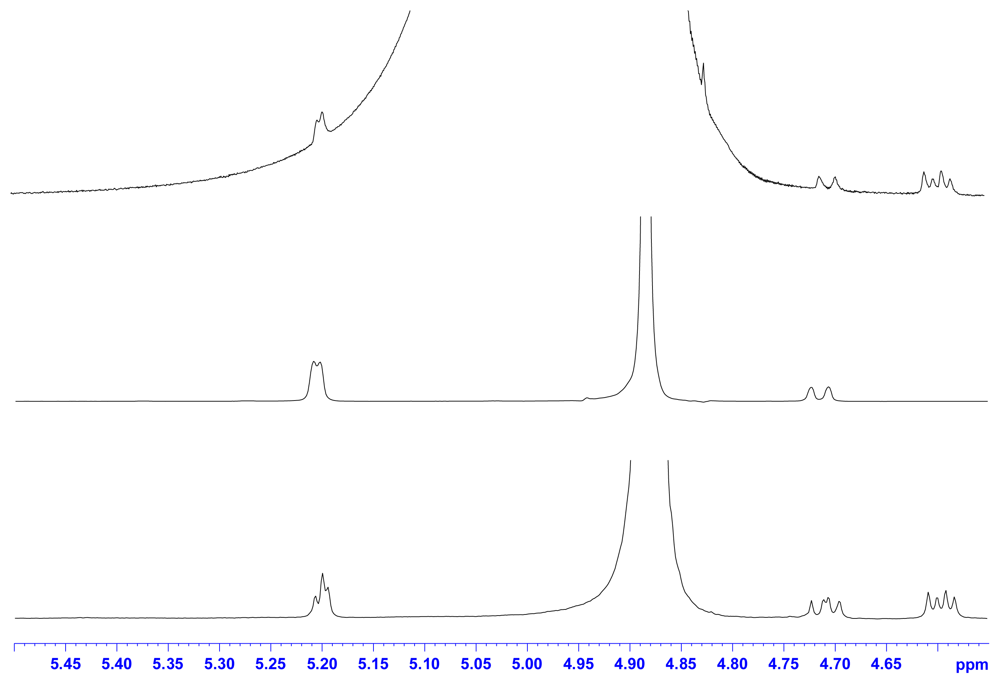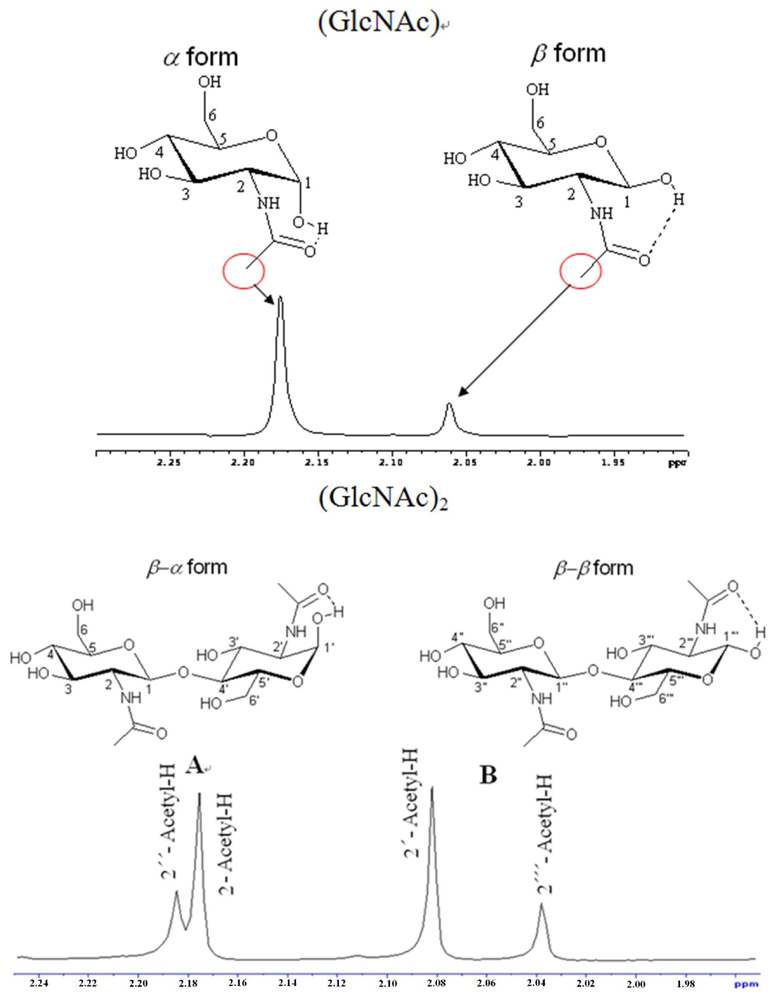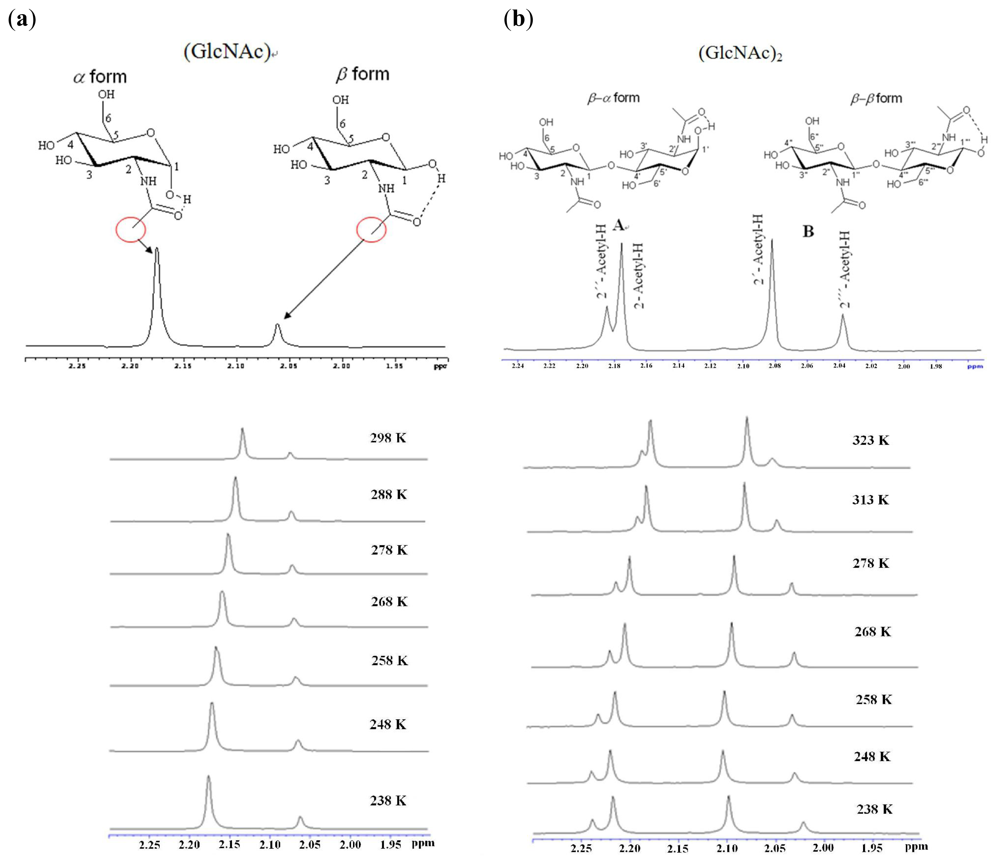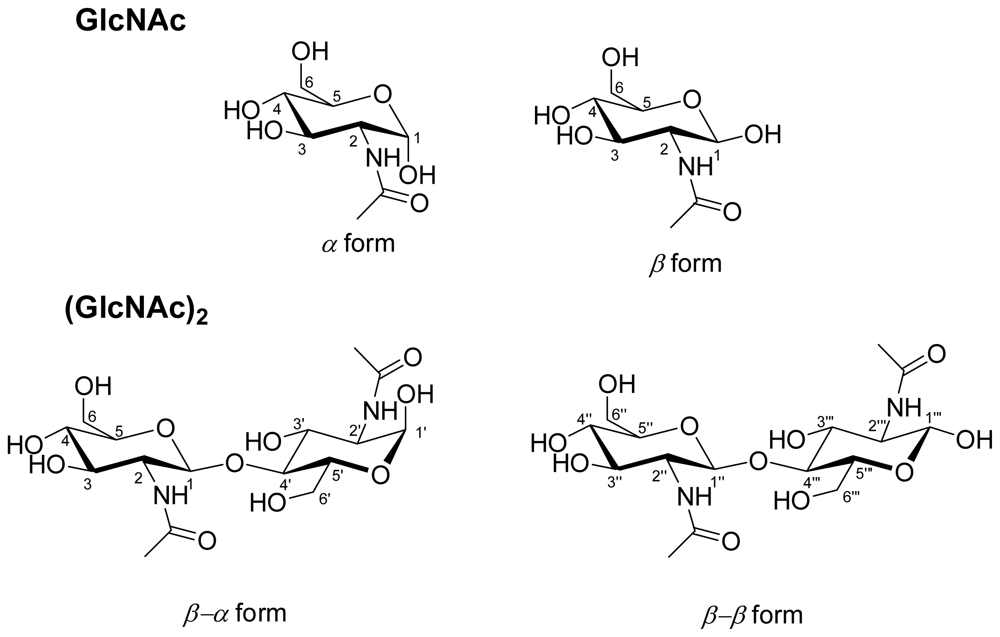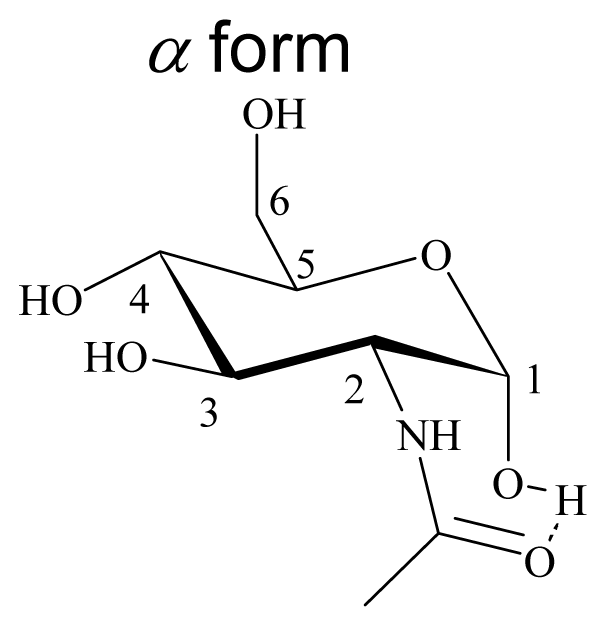2.1. Quality Analysis of Enzyme Hydrolyzed Products
An 1H NMR method was developed to analyze the chitinase-catalyzed chitin hydrolysis products. This method can be used for the analysis of chitin hydrolysis products without destroying of the enzyme activity, and to quantify the contents of products using internal standard without need of the calibration curves. Especially, this method has an excellent correlation between concentration of the products and integration of the peak, also the ratio’s of α,β conformers of products.
With the enzyme catalysis of chitin, two kinds of hydrolysate were obtained:
α/
β GlcNAc and
β-
α/
β-
β (GlcNAc)
2 (
Scheme 1). The analysis of the
1H-NMR spectrum of the standard GlcNAc, (GlcNAc)
2, and hydrolysates shows that
N-acetyl groups and anomeric protons can be selected as target signals for quantification (
Figures 1 and
2). We chose TSP as an internal standard because it is a very stable compound with a simple
1H-NMR spectrum consisting of a singlet (
δ 0.00). The quantities of the compounds were calculated using the relative ratio of the intensity of each compound to a known amount of the internal standard. The chemical shifts of
α/
β GlcNAc and
β-
α/
β-
β (GlcNAc)
2 are quite easy to assign (
Table 1), but some signals overlap. This can be solved using the deconvolution routine of Bruker NMR software, making the
N-acetyl groups of GlcNAc and (GlcNAc)
2 distinguishable. The deconvolution allows the determination of the individual areas and the line widths of the overlapped signals. Thus, it can be used for quantifying GlcNAc and (GlcNAc)
2. In addition, anomeric protons of
α/
β GlcNAc and
β-
α/
β-
β (GlcNAc)
2 appeared in the range 5.3–4.5 ppm; therefore, this is the working region for determining the ratio of
α/
β GlcNAc and the ratio of
β-
α/
β-
β (GlcNAc)
2. However, when acquiring an NMR spectrum at 305 K, the signals H
β-1 and H
β-1″ of (GlcNAc)
2 overlap with the H
2O background signal. In order to prevent this overlap, the NMR working temperature was changed to 290 K. The signals H
β-1and H
β-1″ can then be used for quantifying the β-α and β-β forms of (GlcNAc)
2 using the NMR deconvoluting technique. Furthermore,
α-GlcNAc and
β-GlcNAc can be determined by subtracting the overlapping signals from
α/
β GlcNAc and
β-
α/
β-
β (GlcNAc)
2.
Calibration curves was determined in the concentration ranges for GlcNAc and (GlcNAc)
2 to evaluate the accuracy of this method at various concentrations, respectively. The calibration curves were made using the ratio of the peak integral of the compound and the internal standard (TSP) (
Table 2). The linearity of the calibration curves was determined by plotting the least squares regression lines. All calibration curves were highly linear with a
r2-value of more than 0.999. Because all preliminary quantifications were well within the linear range of this method, we can conclude that these values were accurate. It should be noted that these calibration curves are not needed for quantifying the compounds in future experiments because the area of each signal is proportional to the molar concentration of the corresponding compound in
1H-NMR.
An HPLC method was used to confirm the analysis results obtained using the
1H-NMR method (
Table 3). HPLC methods only obtain the total yield of GlcNAc and (GlcNAc)
2; they cannot determine the ratio of
α/
β GlcNAc and the ratio of
β-
α/
β-
β (GlcNAc)
2. Therefore, the NMR method is simple, rapid, and specific; no reference compounds are needed. An overall profile of the preparation can be obtained directly.
Using the proposed method, the production of GlcNAc and (GlcNAc)
2 can be analyzed in a much shorter time than that required for conventional chromatographic methods. We report a systematic study on a commercial chitinase derived from
Streptomyces griseus HUT-6037 (EC 3.2.1.14), which leads to a higher efficiency of GlcNAc and (GlcNAc)
2 production from
α-chitin. The experiments were carried out in different pH phosphate buffer solutions to estimate the activity of chitinase. This enzyme was tested for hydrolytic activity of
α-chitin at pH 5~9 within 5 days and the amount of GlcNAc and (GlcNAc)
2 by chitinase from
Streptomyces griseus HUT-6037 at various pH values summaries in
Table 4. The amount of (GlcNAc)
2 is the highest at pH = 9, however, the amount of (GlcNAc) is the highest at pH = 5. When chitinase hydrolysis reaction was set in the acidic range, the yield of GlcNAc significantly increased with incubation time. However, the yield of (GlcNAc)
2 reached its maximum after 3 days, and then decreased slowly. The results indicate that acid hydrolysis of (GlcNAc)
2 might occur, resulting in GlcNAc production. When the pH was 7, GlcNAc and (GlcNAc)
2 were produced at the same rate. After 5 days, the yield of GlcNAc was the same as that of (GlcNAc)
2. A study on chitinolytic activity in the basic range showed that a significant yield of (GlcNAc)
2 can be obtained observed at pH 9. However, the percent yield of GlcNAc production increased only slightly. The results indicate that the acid hydrolysis of (GlcNAc)
2 does not happen and that it does not transfer to GlcNAc. The ratio of
α/
β GlcNAc and the ratio of
β-
α/
β-
β (GlcNAc)
2 were also evaluated (
Table 4). The yield of
β-
α (GlcNAc)
2 was significantly higher than that of
β-
β (GlcNAc)
2, while the yield of GlcNAc was higher for the
β form.
2.2. Kinetic Properties of Enzyme Hydrolyzed Products
The kinetic properties of enzyme hydrolyzed products were determined experimentally using VT-NMR.
Figure 3 shows the
1H-NMR signal of (GlcNAc) and (GlcNAc)
2 in pyridine-
d5.
We can evaluate the rate constant from
Equation (1) at various temperatures [
16].
where Δ
vo is the difference of chemical shifts of the acetyl peak (α form and β form) at the lowest temperature (
T = 238 K). With the increase of temperature, the acetyl peak positions of GlcNAc α form and β form are close from 238 to 298 K (
Figure 4). Δ
vp is the difference of chemical shifts of the acetyl peak at the present temperature (
T = 248–343 K for (GlcNAc), and
T = 248–338 K for (GlcNAc)
2). The rate constant (
k) of (GlcNAc) and (GlcNAc)
2 at various temperatures is summarized in
Table 5. The column headings “A” and “B” refer to the chemical shift difference of β-a/β-β form (GlcNAc)
2. The temperature calibration of the VT-NMR has been studied using polynomial fitting (
k =
a0 +
a1T +
a2T2 +
a3T3), the fitting parameters of kinetic constants (
k) for (GlcNAc) and (GlcNAc)
2 at various temperatures are summarized in
Table 6.
From the
1H-NMR study of (GlcNAc)
2 in pyridine-
d5, the signal of the α-form acetyl group increases with reaction time; however, the signal of the β-form acetyl group decreases, implying opening and closing of the ring in (GlcNAc)
2 [
17–
19]. The signal magnitude of the β-form acetyl group changes to the signal magnitude of the α-form acetyl group gradually, suggesting that the intramolecular hydrogen bonds of (GlcNAc)
2 in pyridine-
d5 make α-form more stable than β-form.
2.3. Equilibrium Geometries
Density functional theory (DFT) is a quantum mechanical method used in physics and chemistry to investigate the equilibrium geometric structure [
20–
26]. The geometrical properties of
N-acetyl-
d-glucosamine were studied with density functional theory (DFT) using the Gaussian 03 program package, as shown in
Figure 5. The calculations were done on a B3LYP/6-31G(d) level for geometry optimizations in the ground state. B3LYP is a hybrid function modified from the three-parameter exchange-correlation functional of Becke [
20], while the gradient-corrected exchange and correlation functions are calculated according to Becke [
21] and Lee
et al. [
22]. The geometrical parameters (bond length, bond angle, and bond energy of intramolecular hydrogen bonds) were studied from the optimized equilibrium geometries. The geometric parameters of
N-acetyl-
d-glucosamine are summarized in
Table 7. The bond lengths and bond angles of α-form
N-acetyl-
d-glucosamine are similar to those of β-form
N-acetyl-
d-glucosamine, except bond angle ∠O-H-O shows significant difference between α-form (∠O9-H30-O25 = 163.29°) and β-form (∠O15-H30-O25 = 150.35°)
N-acetyl-
d-glucosamine. The bond length and bond energy of intramolecular hydrogen bonds (O25-H30) from α-form
N-acetyl-
d-glucosamine are 1.78 Å and 10 kJ/mole, respectively, whereas those from β-form
N-acetyl-
d-glucosamine are 1.82 Å and 8 kJ/mole, respectively. There is a relationship of the conformational study of GlcNAc to the NMR experiments. α form GlcNAc shows shorter intramolecular hydrogen bond length 1.78 Å than β form GlcNAc (1.82 Å), the chemical shift of
1H NMR shows acetyl signal of β form GlcNAc is upfield than α form GlcNAc.
